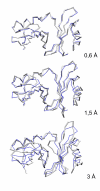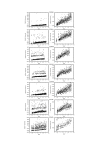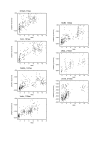Towards the high-resolution protein structure prediction. Fast refinement of reduced models with all-atom force field
- PMID: 17603876
- PMCID: PMC1933428
- DOI: 10.1186/1472-6807-7-43
Towards the high-resolution protein structure prediction. Fast refinement of reduced models with all-atom force field
Abstract
Background: Although experimental methods for determining protein structure are providing high resolution structures, they cannot keep the pace at which amino acid sequences are resolved on the scale of entire genomes. For a considerable fraction of proteins whose structures will not be determined experimentally, computational methods can provide valuable information. The value of structural models in biological research depends critically on their quality. Development of high-accuracy computational methods that reliably generate near-experimental quality structural models is an important, unsolved problem in the protein structure modeling.
Results: Large sets of structural decoys have been generated using reduced conformational space protein modeling tool CABS. Subsequently, the reduced models were subject to all-atom reconstruction. Then, the resulting detailed models were energy-minimized using state-of-the-art all-atom force field, assuming fixed positions of the alpha carbons. It has been shown that a very short minimization leads to the proper ranking of the quality of the models (distance from the native structure), when the all-atom energy is used as the ranking criterion. Additionally, we performed test on medium and low accuracy decoys built via classical methods of comparative modeling. The test placed our model evaluation procedure among the state-of-the-art protein model assessment methods.
Conclusion: These test computations show that a large scale high resolution protein structure prediction is possible, not only for small but also for large protein domains, and that it should be based on a hierarchical approach to the modeling protocol. We employed Molecular Mechanics with fixed alpha carbons to rank-order the all-atom models built on the scaffolds of the reduced models. Our tests show that a physic-based approach, usually considered computationally too demanding for large-scale applications, can be effectively used in such studies.
Figures




Similar articles
-
Protein structure prediction: combining de novo modeling with sparse experimental data.J Comput Chem. 2007 Jul 30;28(10):1668-76. doi: 10.1002/jcc.20657. J Comput Chem. 2007. PMID: 17342709
-
Hierarchical modeling of protein interactions.J Mol Model. 2007 Jul;13(6-7):691-8. doi: 10.1007/s00894-007-0177-8. Epub 2007 Feb 13. J Mol Model. 2007. PMID: 17297609
-
Protein structure evaluation using an all-atom energy based empirical scoring function.J Biomol Struct Dyn. 2006 Feb;23(4):385-406. doi: 10.1080/07391102.2006.10531234. J Biomol Struct Dyn. 2006. PMID: 16363875
-
Protein modeling and structure prediction with a reduced representation.Acta Biochim Pol. 2004;51(2):349-71. Acta Biochim Pol. 2004. PMID: 15218533 Review.
-
Mass spectrometry coupled experiments and protein structure modeling methods.Int J Mol Sci. 2013 Oct 15;14(10):20635-57. doi: 10.3390/ijms141020635. Int J Mol Sci. 2013. PMID: 24132151 Free PMC article. Review.
Cited by
-
eThread: a highly optimized machine learning-based approach to meta-threading and the modeling of protein tertiary structures.PLoS One. 2012;7(11):e50200. doi: 10.1371/journal.pone.0050200. Epub 2012 Nov 21. PLoS One. 2012. PMID: 23185577 Free PMC article.
-
Structural allele-specific patterns adopted by epitopes in the MHC-I cleft and reconstruction of MHC:peptide complexes to cross-reactivity assessment.PLoS One. 2010 Apr 26;5(4):e10353. doi: 10.1371/journal.pone.0010353. PLoS One. 2010. PMID: 20442757 Free PMC article.
-
Predicting the complex structure and functional motions of the outer membrane transporter and signal transducer FecA.Biophys J. 2008 Apr 1;94(7):2482-91. doi: 10.1529/biophysj.107.116046. Epub 2008 Jan 4. Biophys J. 2008. PMID: 18178655 Free PMC article.
-
CABS-fold: Server for the de novo and consensus-based prediction of protein structure.Nucleic Acids Res. 2013 Jul;41(Web Server issue):W406-11. doi: 10.1093/nar/gkt462. Epub 2013 Jun 8. Nucleic Acids Res. 2013. PMID: 23748950 Free PMC article.
-
Combining coarse-grained protein models with replica-exchange all-atom molecular dynamics.Int J Mol Sci. 2013 May 10;14(5):9893-905. doi: 10.3390/ijms14059893. Int J Mol Sci. 2013. PMID: 23665897 Free PMC article.
References
-
- Simmerling C, Lee MR, Ortiz AR, Kolinski A, Skolnick J, Kollman PA. Combining MONSSTER and LES/PME to Predict Protein Structure from Amino Acid Sequence: Application to the Small Protein CMTI-1. J Am Chem Soc. 2000;122:8392 –88402. doi: 10.1021/ja993119k. - DOI
MeSH terms
Substances
LinkOut - more resources
Full Text Sources

